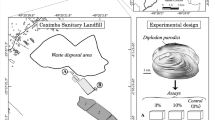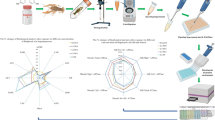Abstract
Paraquat is a quaternary herbicide widely used for broadleaf weed control, which has been known to be a highly toxic compound for humans and animals. Therefore, analysis and development of biomarkers of exposure are undoubtedly valuable in evaluating the toxicity of paraquat contaminated water bodies. The effect of a single exposure of paraquat (1 ppm) for 24 h on various non-enzymatic antioxidants was studied in freshwater fish Channa punctata (Bloch). The levels of the reduced glutathione were significantly reduced in the liver and gill of exposed fish. The total and protein thiol levels were increased in all the tissues of the exposed fish. The non-protein thiol levels were reduced in liver and gill. The levels of ascorbic acid increased in liver. The uric acid level increased significantly in kidney and decreased significantly in gill of the exposed fish. The findings of the present investigation demonstrate the oxidative-stress-inducing potential of the herbicide paraquat in fish. This work indicated the possibility of using non-enzymatic antioxidants as biomarkers of exposure to environmental contamination and subsequent validation as a sensitive system for biomonitoring and ecotoxicological risk assessment.


Similar content being viewed by others
References
Ahmad I, Hamid T, Fatima M, Chand HS, Jain SK, Athar M, Raisuddin S (2000) Induction of hepatic antioxidants in freshwater catfish (Channa punctatus Bloch.) is a biomarker of paper mill effluent exposure. Biochem Biophys Acta 1523:37–48
Akerman G, Amcoff P, Tjarnlund U, Fogelberg K, Torrissen O, Balk L (2003) Paraquat and menadione exposure of rainbow trout (Oncorhynchus mykiss)–studies of effects on the pentose-phosphate shunt and thiamine levels in liver and kidney. Chem Biol Interact 142:269–283
Ali S, Diwakar G, Pawa S (2000) Paraquat induces different pulmonary biochemical responses in Wistar rats and Swiss mice. Chemico Biol Interact 125:79–91
Ames B, Cathcart R, Schwiers E, Hochstein P (1981) Uric acid provides an antioxidant defense in human against oxidant and radical-caused aging and cancer: A Hypothesis. Proc Natl Acad Sci 78:6858–6862
Anderson ME (1997) Glutathione and glutathione delivery compounds. Adv Pharmacol 38:65–78
Anderson ME, Luo JL (1998) Glutathione therapy: from prodrugs to genes. Semin Liver Dis 18:415–424
Andersson T, Forlin L, Hardig J, Larsson A (1988) Physiological disturbances in fish living in coastal water polluted with bleached kraft pulp mill effluents. Can J Fish Aquat Sci 45:1525–1536
APHA (1998) Standard Methods for the Examination of Water and Waste-Water, 20th edition. In: Clesceri LS, Greenberg AE, Eaton AD, editors. American Public Health Association, Washington, DC
Asztalos B, Nemcsok J (1985) Effect of pesticides on the LDH activity and soenzyme pattern of carp (Cyprinus carpio L.) sera. Comp Biochem Physiol 82:217–219
Balcerczyk A, Grzelak A, Janaszewska A, Jakubowski W, Koziol S, Marszalek M, Rychlik B, Soszynski M, Bilinski T, Bartosz G (2003) Thiols as major determinants of the total antioxidant capacity. Biofactors 17:75–82
Baldwin RC, Pasi A, MacGregor JT, Hine CH (1975) The rates of radical formation from the dipridylium herbicides paraquat, diquat and morfamquat in homogenates of rat lung, kidney and liver: An inhibitory effect of carbon monoxide. Toxicol Appl Pharmacol 32:298–304
Bismuth C, Garnier R, Baud FJ, Muszynski J, Keyes C (1990) Paraquat poisoning. An overview of the current status. Drug Saf 5:243–251
Boxall AB, Brown CD, Barrett KL (2002) Higher-tier laboratory methods for assessing the aquatic toxicity of pesticides. Pest Manag Sci 58:637–648
Bullivant CM (1966) Accidental poisoning by paraquat. Br Med J 1:1272–1273
Bus JS, Aust SD, Gibson JE (1974) Superoxide-and singlet oxygen catalyzed lipid peroxidation as a possible mechanism for paraquat (methyl viologen) toxicity. Biochem Biophys Res Commun 58:749–755
Carr A, Frei B (1999) Does vitamin C act as a pro-oxidant under physiological conditions? Faseb J 13:1007–1024
Combs GF Jr, Peterson FJ (1983) Protection against acute paraquat toxicity by dietary selenium in the chick. J Nutr 113: 538–545
Copland GM, Kolin A, Shulman HS (1974) Fatal pulmonary intra-alveolar fibrosis after paraquat ingestion. N Engl J Med 291:290–292
Dafre AL, Medeiros ID, Muller IC, Ventura EC, Bainy AC (2004) Antioxidant enzymes and thiol/disulfide status in the digestive gland of the brown mussel Perna perna exposed to lead and paraquat. Chem Biol Interact 149:97–105
DeLorenzo ME, Scott GI, Ross PE (2001) Toxicity of pesticides to aquatic microorganisms: a review. Environ Toxicol Chem 20:84–98
Deneke SM (2000) Thiol based antioxidants. Curr Top Cell Reg 36:151–180
Di Marzio W, Tortorelli MC (1994) Effects of paraquat on survival and total cholinesterase activity in fry of Cnesterodon decemmaculatus (Pisces, Poeciliidae). Bull Environ Contam Toxicol 52:274–278
Ellenhorn MJ, Schonwald S, Ordog G, Wasserberger J (1997) In: Ellenhorn´s Medical Toxicology: Diagnosis & Treatment of Human poisoning, Willliams & Wilkins, Maryland, 1614–1663
Esser HO (1986) Comparative aspects of herbicide metabolism. Xenobiotica 16:1031–1045
Evans P, Halliwell B (2001) Micronutrients: oxidant/antioxidant status. Br J Nutr 85:S67–74
Fitzgerald GR, Barniville G, Flanagan M, Silke B, Carmody M, O’Dwyer WF (1978) The changing pattern of paraquat poisoning: an epidemiologic study. J Irish Med Assoc 71:103–108
Fytizas R (1980) Toxicity of paraquat to three marine organisms. Bull Environ Contmn Toxicol 25:283–288
Gabryelak T, Klekot J (1985) The effect of paraquat on the peroxide metabolism enzymes in erythrocytes of freshwater fish species. Comp Biochem Physiol 81:415–418
Gram TE (1997) Chemically reactive intermediates and pulmonary xenobiotic toxicity. Pharmacol Rev 49:297–341
Halliwell B (1996) Vitamin C: antioxidant or pro-oxidant in vivo? Free Radic Res 25:439–454
Jollow DW, Mitchell JR, Zampagilone N, Gilete JR (1974) Bromobenzene induced liver necrosis: protective role of glutathione and evidence for 3, 4- bromobenzeneoxide as the hepatotoxic intermediate. Pharmacol 11:151–169
Kang SA, Jang YJ, Park H (1998) In vivo dual effects of vitamin C on paraquat-induced lung damage: dependence on released metals from the damaged tissue. Free Radical Res 28:93–107
Kimbrough RD, Gaines TB (1970) Toxicity of paraquat to rats and its effect on rat lungs. Toxicol Appl Pharmacol 17:679–690
Klimek J, Schaap AP, Kimura T (1983) Effect of paraquat on cytochrome P-450-dependent lipid peroxidation in bovine adrenal cortex mitochondria. Biochem Biophys Acta 752:127–136
Kosower NS, Kosower EN. 1978. The glutathione status of cells. Int Rev Cytol 54:109–160
Matkovics B, Szabo L, Varga SI, Barabas K, Berencsi G, Nemcsok J (1984) Effects of a herbicide on the peroxide metabolism enzymes and lipid peroxidation in carp fish (Hypophthalmichthys molitrix). Acta Biol Hung 35:91–96
Matkovicks B, Witas H, Gabrielak T Szabo L (1987) Paraquat as an agent affecting antioxidant enzymes of common carp erythrocytes. Comp Biochem Physiol 87:217–219
Nakagawa I, Suzuki M, Imura N, Naganuma A (1995) Enhancement of paraquat toxicity by glutathione depletion in mice in vivo and in vitro. J Toxicol Sci 20:557–564
Pandey S, Ahmad I, Parvez S, Bin-Hafeez B, Haque R, Raisuddin S (2001) Effect of endosulfan on antioxidants of freshwater fish Channa punctatus Bloch.: 1. Protection against lipid peroxidation in liver by copper preexposure. Arch Environ Contam Toxicol 41:345–352
Parvez S, Raisuddin S (2005) Protein carbonyls: novel biomarkers of exposure to oxidative stress-inducing pesticides in freshwater fish Channa punctata (Bloch) Environ Toxicol Pharmacol 20:112–117
Parvez S, Sayeed I, Pandey S, Ahmad A, Bin-Hafeez B, Haque R, Ahmad I, Raisuddin S (2003) Modulatory effect of copper on nonenzymatic antioxidants in freshwater fish Channa punctatus (Bloch.). Biol Trace Elem Res 93:237–248
Quiroga GB, Lopez-Torres M, Perez-Campo R, Rojas C (1991) Simultaneous determination of two antioxidants, uric acid and ascorbic acid in animal tissues by high performance liquid chromatography. Anal Biochem 199:81–85
Rahman Q, Abidi P, Afaq F, Schiffmann D, Mossman BT, Kamp DW, Athar M (1999) Glutathione redox system in oxidative lung injury. Crit Rev Toxicol 29:543–568
Reed DJ, Beatty PW (1980) Biosynthesis and regulation of glutathione: Toxicological implications. In: Hodgson E, Bend JR, Philpot RM, editors. Reviews in biochemical toxicology. Elsevier, Amsterdam. p 213–241
Reyes AJ (2003) Cardiovascular drugs and serum uric acid. Cardiovasc Drugs Ther 17:397–414
Sayeed I, Parvez S, Pandey S, Bin-Hafeez B, Haque R, Raisuddin S (2003) Oxidative stress biomarkers of exposure to deltamethrin in freshwater fish, Channa punctatus Bloch. Ecotoxicol Environ Saf 56:295–301
Sedlak J, Lindsay HR (1968) Estimation of total, protein-bound and nonprotein sulfhydryl groups in tissues with Ellman’s Reagent. Anal Biochem 25:192–205
Singer MA (2003) Do mammals, birds, reptiles and fish have similar nitrogen conserving systems? Comp Biochem Physiol 134:543–558
Suntres ZE (2002) Role of antioxidants in paraquat toxicity. Toxicology 180:65–77
Telo JP (2003) Radicals derived from uric acid and its methyl derivatives in aqueous solution: an EPR spectroscopy and theoretical study. Org Biomol Chem 1:588–592
Tortorelli MC, Hernandez DA, Vazquez GR, Salibian A (1990) Effects of paraquat on mortality and cardiorespiratory function of catfish fry Plecostomus commersoni. Arch Environ Contam Toxicol 19:523–529
Tucker BW, Halver JE (1986) Utilization of ascorbte-2-sulfate in fish. Fish Physiol Biochem 2:151–160
Uchiyama M, Mihara M (1978) Determination of malonaldehyde precursor in tissues by thiobarbituric acid test. Anal Biochem 86:271–278
Vasseur P, Cossu-Leguille C (2003) Biomarkers and community indices as complementary tools for environmental safety. Environ Int 28:711–717
Vigano L, Arilloi A, Falugi C, Melodia F, Polesello S (2001) Biomarkers of exposure and effect in flounder (Platichthys flesus) exposed to sediments of the Adriatic sea. Mar Pollut Bull 42:887–894
Vismara C, Bacchetta R, Cacciatore B, Vailati G, Fascio U (2001) Paraquat embryotoxicity in the Xenopus laevis cleavage phase. Aquat Toxicol 55:85–93
Acknowledgments
The authors acknowledge the Ministry of Environment and Forests (Government of India) for financial support.
Author information
Authors and Affiliations
Corresponding author
Rights and permissions
About this article
Cite this article
Parvez, S., Raisuddin, S. Effects of Paraquat on the Freshwater Fish Channa punctata (Bloch): Non-Enzymatic Antioxidants as Biomarkers of Exposure. Arch Environ Contam Toxicol 50, 392–397 (2006). https://doi.org/10.1007/s00244-005-5083-4
Received:
Accepted:
Published:
Issue Date:
DOI: https://doi.org/10.1007/s00244-005-5083-4




